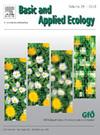Sheep grazing in vineyards benefits wild bees in vineyard embankments and sheep dung attracts dung beetles to vineyards
IF 3.5
2区 环境科学与生态学
Q2 ECOLOGY
引用次数: 0
Abstract
Integrated sheep-vineyard systems are an example of ecological intensification. Sheep can replace mulching, thereby reducing the input of fossil fuels and agrochemicals. However, knowledge about the co-benefits of sheep grazing for biodiversity is lacking. This study examined the impact of grazing on wild bee diversity within terraced vineyards and vineyard embankments. Additionally, dung beetle colonization of sheep dung was investigated in the wine-growing region of southwestern Germany. Five vineyards and their terrace risers (embankments) had been grazed by sheep for several years, typically in a rotational system, or were managed conventionally by mulching as control. Wild bee diversity was compared in five pairs of grazed and non-grazed vineyards and five pairs of grazed and non-grazed embankments within one year. Dung beetle diversity, reared from sheep dung collected at three grazed vineyards, was also assessed. In the vineyards, bee abundance and species richness did not differ between grazed plots and mulched controls, but bee abundance increased with flower abundance, and bee species richness increased with flowering herb species richness. In contrast, on vineyard embankments, both species richness and abundance of wild bees were higher on grazed embankments compared to control embankments, whereas flower cover did not have any effect. At least 20 different dung beetle species, including threatened ones, were recorded in sheep droppings of grazed vineyards. This additional food resource may support dung beetle populations, contributing to overall insect biomass, with potential relevance for nature conservation. Our study shows that sheep grazing may support dung beetles, but does not affect bees in vineyards. However, allowing sheep to access vineyard embankments for vegetation management supports wild bees. Therefore, sheep grazing in vineyards offers opportunities for biodiversity conservation and maintaining ecosystem functions, though is not an all-in-one solution.
在葡萄园里吃草的羊有利于葡萄园堤岸上的野蜂,而羊粪吸引蜣螂到葡萄园来
综合羊-葡萄园系统是生态集约化的一个例子。绵羊可以代替地膜,从而减少化石燃料和农用化学品的投入。然而,关于放羊对生物多样性的共同利益的认识是缺乏的。本研究考察了放牧对梯田葡萄园和葡萄园堤防内野生蜜蜂多样性的影响。此外,在德国西南部的葡萄酒产区调查了蜣螂对羊粪的定植。五个葡萄园和它们的梯田(堤岸)已经被羊放牧了好几年了,通常是轮作的,或者是用覆盖物作为控制的传统管理。在一年内比较了5对放牧和非放牧的葡萄园以及5对放牧和非放牧的堤岸的野生蜜蜂多样性。还评估了从三个放牧葡萄园收集的羊粪中饲养的屎壳郎多样性。在葡萄园中,蜜蜂丰度和物种丰富度在放牧地和覆盖地之间无显著差异,但蜜蜂丰度随花卉丰度的增加而增加,蜜蜂物种丰富度随开花草本物种丰富度的增加而增加。相比之下,在葡萄园堤岸上,放牧堤岸的野生蜜蜂物种丰富度和丰度都高于对照堤岸,而覆盖对其没有任何影响。至少有20种不同的屎壳郎,包括濒临灭绝的屎壳郎,被记录在放牧葡萄园的绵羊粪便中。这种额外的食物资源可能会增加屎壳郎的数量,增加昆虫的总生物量,对自然保护具有潜在的意义。我们的研究表明,放牧可能会支持屎壳郎,但不会影响葡萄园里的蜜蜂。然而,允许羊进入葡萄园的堤岸进行植被管理支持野生蜜蜂。因此,在葡萄园放牧为生物多样性保护和维持生态系统功能提供了机会,尽管这不是一个一体化的解决方案。
本文章由计算机程序翻译,如有差异,请以英文原文为准。
求助全文
约1分钟内获得全文
求助全文
来源期刊

Basic and Applied Ecology
环境科学-生态学
CiteScore
6.90
自引率
5.30%
发文量
103
审稿时长
10.6 weeks
期刊介绍:
Basic and Applied Ecology provides a forum in which significant advances and ideas can be rapidly communicated to a wide audience. Basic and Applied Ecology publishes original contributions, perspectives and reviews from all areas of basic and applied ecology. Ecologists from all countries are invited to publish ecological research of international interest in its pages. There is no bias with regard to taxon or geographical area.
 求助内容:
求助内容: 应助结果提醒方式:
应助结果提醒方式:


